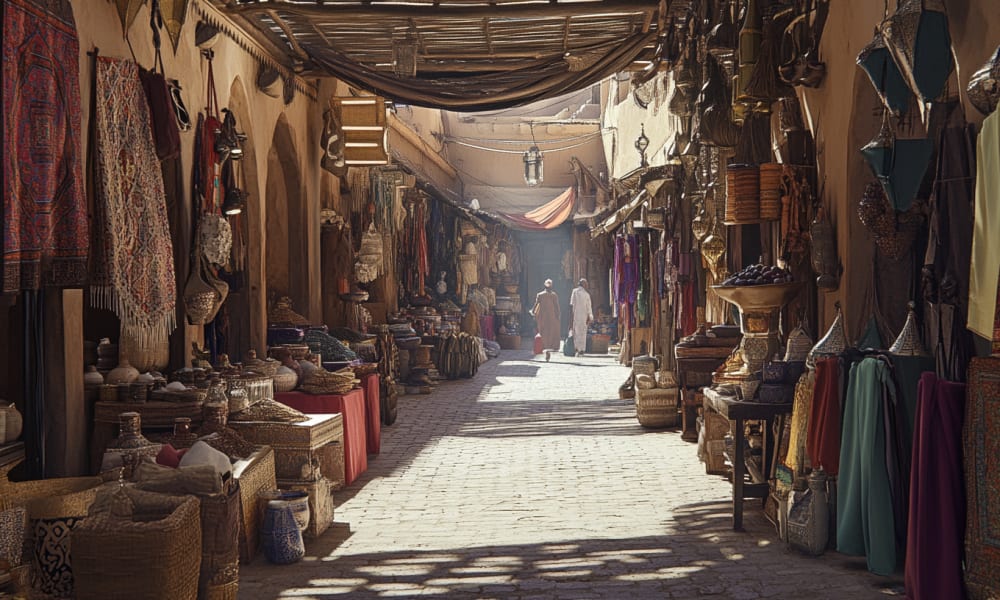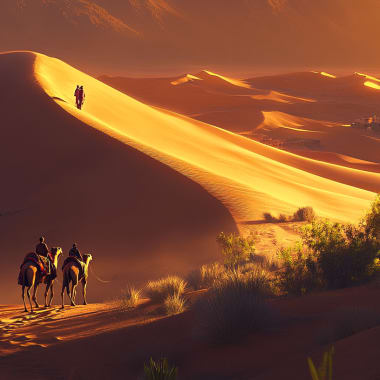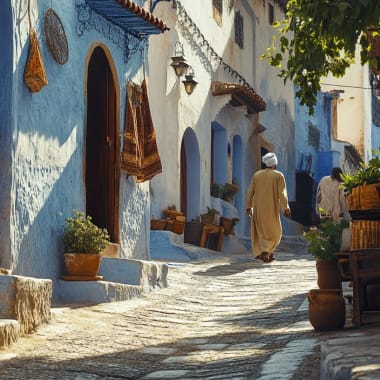
The Best Souks and Bazaars in Morocco
A feast for the senses—discover Morocco’s most captivating markets filled with tradition, craftsmanship, and a touch of the exotic.
A feast for the senses—discover Morocco’s most captivating markets filled with tradition, craftsmanship, and a touch of the exotic.
Winding through the alleys of Morocco’s old cities, one thing quickly becomes clear: souks and bazaars are the beating heart of every medina. They’re places where the scent of spices fills the air, vibrant textiles drape from every stall, and the buzz of daily life surrounds you. Each market is a world of its own—layered, colorful, and deeply rooted in local culture. In this article, we’re taking you to four of Morocco’s most memorable souks, where authentic encounters and unforgettable shopping experiences await.
Souk Semmarine, Marrakesh
A vibrant classic at the heart of the medina—where color, sound, and craftsmanship come alive.
Where Tradition Meets Energy: What Makes This Souk Special
Souk Semmarine is the largest and most central market in Marrakesh’s medina, often described as the pulsing heart of the city’s trading scene. The sheer variety is dazzling: handwoven rugs, bold textiles, fine leather goods, gleaming jewelry, and fragrant spices pack the stalls in every direction. Wooden canopies shade the narrow alleys, casting a soft, dappled light that adds to the market’s magical, almost mystical atmosphere.
As the main artery of the souk system, Semmarine branches off into neighboring markets like Souk Nejjarine and Souk El-Kebir—creating a lively maze that’s made for exploring. For more than a thousand years, this place has served as a key trading post for merchants from across Morocco and beyond. Many of the goods—like carpets or spice blends—are still produced using traditional techniques, reflecting the country’s rich artisanal heritage.
Despite its popularity with visitors, Souk Semmarine remains a deeply authentic place. It's not just about shopping—it’s about experiencing everyday life in Marrakesh. With the hum of voices, bursts of color, and shifting light filtering through the alleys, the market is a full-sensory immersion into Moroccan culture.
A Tapestry of Color, Scent, and Craft: What You’ll Find
Entering Souk Semmarine is like stepping into a living gallery of Moroccan craftsmanship. Some of the most sought-after items include:
- Rugs and Textiles – Handwoven Berber carpets, colorful cushions, and decorative throws that showcase the artistry of local weaving traditions.
- Leather Goods – From classic babouches (slippers) and bags to belts and jackets, all made from leather processed in Marrakesh’s historic tanneries.
- Ceramics and Pottery – Hand-painted plates, bowls, and tajines featuring bold, geometric patterns.
- Spices and Delicacies – From ras el hanout and saffron to preserved lemons, olives, and sweet treats like nougat.
- Jewelry and Metalwork – Intricately designed silver and gold jewelry, as well as beautifully crafted lanterns and trays made of brass or copper.
The craftsmanship itself is a highlight: vendors happily explain the symbols woven into rugs, guide you through the bargaining process, and invite you to see how items are made. In nearby areas like the Dyers’ Souk, you can even watch as fabrics are dyed in vibrant hues. Whether it’s a woven rug, a hand-hammered lamp, or a stitched leather bag—many pieces are created just steps from where they’re sold.
If you’re curious, strike up a conversation. Many artisans are proud to share their stories, techniques, and materials. This is no anonymous market—it’s a space where tradition is alive and personal.
Tips for Visiting: Make the Most of Your Souk Experience
Getting There
Souk Semmarine is located in the heart of Marrakesh’s old town, just north of the famous Jemaa el-Fnaa square. The entrance is easy to spot and makes a great starting point for discovering the rest of the medina’s markets.
When to Go
Shops are typically open daily from 9:00 AM to 7:00 PM. For the most pleasant experience, visit in the morning or early evening, when temperatures are cooler and the light is especially atmospheric.
What to Know
The alleys can feel like a maze, but key landmarks like Jemaa el-Fnaa help with navigation. Bargaining is part of the culture—start low, smile, and don’t be afraid to walk away if needed. Vendors appreciate polite, curious travelers, and those who take the time to engage often walk away with more than just a good deal.
Souk el Attarine, Fès
A fragrant gem in the heart of Fès—where spices, history, and spiritual ambiance come together.
Where Tradition Meets Energy: What Makes This Souk Special
Tucked deep within the historic old town of Fès, Souk el Attarine sits near the famed Qarawiyyin Mosque—a spiritual and intellectual center since the 9th century. Named after the perfume and spice merchants who have traded here for centuries, this souk has long been a hub for the exchange of goods, knowledge, and tradition.
The market’s charm lies in its atmosphere: narrow lanes filled with rich aromas, traditional stalls untouched by modern signage, and a sense of timelessness that speaks for itself. Nearby, the exquisite Al-Attarine Madrasa, one of Morocco’s most beautiful Quranic schools, adds an extra layer of historical depth—highlighting the deep connection between commerce, faith, and learning.
A Feast for the Senses: What You’ll Discover
Souk el Attarine is a paradise for lovers of scent and spice. You’ll find vibrant piles of saffron, ras el hanout, dried mint, figs, dates, herbal teas, and medicinal plants—all carefully arranged and sold by knowledgeable vendors. Natural beauty products like argan oil, rose water, and ghassoul clay are also staples here.
While the focus is on culinary and wellness items, nearby alleyways reveal a glimpse of traditional Moroccan craftsmanship—ceramics, carved wood, and intricate metal lamps are all part of the experience. The souk is alive with conversations, aromas, and color, offering visitors a sensory journey that’s as rich as it is authentic.
Tips for Visiting: Make the Most of Your Souk Experience
Getting There
Souk el Attarine is centrally located in Fès’s medina, close to both the Qarawiyyin Mosque and the Al-Attarine Madrasa. A great starting point is Bab Boujloud (the Blue Gate), from where a scenic walk through the winding alleys will lead you straight into the heart of the market.
When to Go
The best time to visit is in the morning, when the crowds are thinner and the scents and colors are most vivid. Late afternoon can also be a lovely time, as the lighting softens and shopkeepers tend to be more relaxed and talkative.
What to Keep in Mind
Navigating the medina can be tricky—consider using offline maps or hiring a local guide.
Bargaining is expected, but keep it friendly and patient—smiles go a long way.
Avoid visiting during major religious holidays, when many shops may be closed.
Marché Central, Casablanca
A culinary hotspot in the heart of the city—where oysters, architecture, and everyday culture come together.
Where Tradition Meets Energy: What Makes This Market Unique
Right in the bustling center of Casablanca, along Boulevard Mohammed V, lies the Marché Central—a vibrant marketplace that blends culinary flair, colonial-era architecture, and local culture. While it’s a popular stop for curious travelers, it’s first and foremost a place where locals shop, eat, and connect—offering an authentic glimpse into urban Moroccan life.
Built in 1917 during the French protectorate, the market’s grand neo-Moorish design is still striking today. Its imposing arched entrance, central dome, and orderly layout stand in stark contrast to the maze-like alleys of traditional souks elsewhere in Morocco.
What truly sets the Marché Central apart is its fusion of market bustle and culinary experience: here, visitors can purchase fresh seafood and have it cooked right on-site at one of the surrounding restaurants—an experience that’s made the market a beloved institution far beyond Casablanca.
A Feast for the Senses: What You’ll Discover
Marché Central is best known for its fresh food offerings. Beneath the central dome, you’ll find rows of glistening fish, shellfish, and the prized Dakhla oysters, served right on the spot. Flower vendors line the walkways with bursts of color and fragrance, while spice stalls, vibrant produce, and rows of marinated olives offer a rich sensory experience.
Dining here is a highlight in itself. Many restaurants along the market’s edge will cook your market finds to order—making it a perfect spot for a fresh and flavorful lunch. Popular dishes include grilled sardines, spicy fish tagines, and golden-fried calamari—each offering a taste of everyday Moroccan cuisine.
If you’re more in the mood to browse, you’ll also come across small artisan shops selling antiques, handwoven baskets, and local crafts. The unique blend of colonial charm, lively market scenes, and bold flavors makes the Marché Central a true cultural crossroads in the heart of Casablanca.
Tips for Visiting: Make the Most of Your Market Stop
Getting There
The market is centrally located and easily accessible by public transport. Just hop on Tram Line 1 and get off at the “Marché Central” stop—it’s also just a short ride by taxi from most parts of the city.
Opening Hours & Best Time to Visit
The market is open on weekdays from around 8:00 AM to 4:30 PM, and on weekends until 6:00 PM. For the full experience, plan your visit in the late morning when the seafood stalls are at their freshest and the lunch crowds begin to gather.
What to Keep in Mind
The vibe here is welcoming and laid-back, with less bargaining than in other Moroccan markets. While seafood prices are generally fair, it’s smart to ask for costs before ordering. The food is made fresh on the spot, but as always, keep an eye out for cleanliness—especially with shellfish and raw seafood.
Souk Haddadine, Essaouira
Craftsmanship, calm, and coastal charm—this souk is made for curious wanderers.
Where Tradition Feels Personal: What Makes This Souk Special
Tucked into the heart of Essaouira’s old town, Souk Haddadine offers a refreshing contrast to the hustle and bustle of Morocco’s larger markets. Here, the pace is slower, the alleys are wider, and the shopkeepers are relaxed—making it the perfect place for travelers who want to browse without pressure.
This souk is especially known for its artisanal traditions. Visitors can admire finely carved woodwork, delicate metal creations, and handwoven textiles. What sets it apart: many workshops are open to the public, so you can watch artisans in action—adding a layer of authenticity that’s hard to find elsewhere.
Souk Haddadine is deeply intertwined with Essaouira’s past. The city was founded in the 18th century as a port connecting African trade routes with Europe, and its multicultural roots are still visible today. As part of the city’s UNESCO-listed medina, this market is more than a shopping stop—it’s a cultural experience.
A Feast of Craft and Culture: What You’ll Discover
If you’re looking for authentic Moroccan craftsmanship, this is the place to be. Highlights include intricate inlaid boxes and furniture made from fragrant thuja wood—a local specialty. You’ll also find bold Amazigh (Berber) jewelry, hand-crafted musical instruments like the gumbri, and brightly glazed pottery.
In addition to finished products, you’ll witness craftsmanship in motion. Visit a local workshop or artisan center and see traditional methods at work: the rhythmic hammering of the blacksmiths, the careful carving of woodworkers, or the weaving of richly colored fabrics.
For those seeking thoughtful souvenirs, there are also regionally produced goods like Argan oil, spices, and hand-dyed textiles—often sold directly by the makers. It’s a great place to shop sustainably and support local artisans.
Tips for Visiting: A Relaxed Way to Explore
Souk Haddadine is centrally located in Essaouira’s compact medina and easy to reach on foot. A visit in the morning or late afternoon is ideal—cooler, quieter, and full of charm.
Navigating the medina is fairly simple compared to larger cities. Landmarks like Place Moulay Hassan can help you stay oriented. Bargaining is expected here too, but it’s more laid-back than in places like Marrakesh. Be polite, take your time, and don’t hesitate to compare prices before making a purchase.
If you’re shopping with intention, look for small workshops or certified cooperatives—especially when buying Argan oil. Supporting local producers means your visit becomes not just a cultural experience, but a meaningful one, too.
Markets That Tell a Story – Your Gateway to Moroccan Culture
Whether lively in Marrakesh, historic in Fès, breezy in Essaouira, or urban in Casablanca—Morocco’s souks are more than just places to shop. They are living, breathing spaces of tradition, creativity, and connection. Step into one with an open mind, and you’ll walk away with far more than souvenirs—you’ll carry a piece of Morocco’s soul.
Discover the Orient with experts who have explored every corner themselves
Your dream holiday, tailor-made by experts.
We don't just know the Middle East from books, we visit the country several times a year to experience the culture, landscape and people first-hand.
From your first enquiry to your return home, we are there for you personally - by phone, email or WhatsApp, whenever you need us. Our trips are as unique as you are: individually planned and provided with exclusive privileges and high-quality arrangements that will make your trip unforgettable.
Experts for your Orient trip







